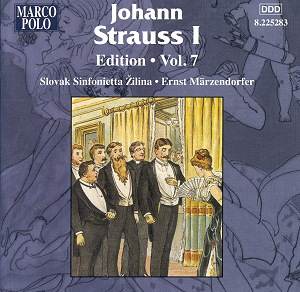Unlike the Marco
Polo editions of Johann Strauss II and his brother Josef, which
were farmed out to a range of conductors, good, bad and indifferent,
the Johann I edition – the previous volumes of which have all
been reviewed by me for the site – continues to be shared between
just two. They are Christian Pollack (vols. 1, 2, 5, 6), who
is perhaps not a very great conductor but who loves the music
and knows how it has to go, and the veteran Ernst Märzendorfer
(vols. 3, 4), the first conductor to put all the Haydn symphonies
on record and a well-respected figure in Vienna. As well as
having the style at his fingertips, he brought about a minor
revolution in the standards of orchestral tuning and ensemble;
only vol. 1, recorded several years before the others, used
a different orchestra. Comparing the admittedly spirited efforts
under Pollack in vol. 2 with Märzendorfer’s performances in
vols. 3 and 4 was rather like seeing a painting before and after
restoration. However, the improvements obtained under Märzendorfer
were fairly well maintained when Pollack took over again for
vols. 5 and 6 and, combined the conductor’s evident enjoyment
of the music. I wondered if these performances did not get the
best of both worlds.
Well, here is Märzendorfer
back for vol. 7, and immediately orchestral discipline is tightened
a stage further. Clearly a great deal of care has been taken
over articulation, phrasing and balance, as well as on the shaping
of the dance rhythms themselves. Yet if this sounds as though
the music has been confined within an iron-clad, Szell-like
grip, the wonder of it is that the sheer enjoyment exuded by
the Pollack performances has not been lost, with the result
that the series reaches a new level of excellence.
Strauss’s own growing
maturity makes the task easier, of course. When reviewing the
first volume in the series I rather upset one reader with my
suggestion that, when vol. 2 came along it wouldn’t make very
much difference if one bought it or simply listened to vol.
1 again, since this was consumer-music. I still think that was
true of the early pieces, but it becomes less and less true
as the series proceeds. Perhaps Johann the father never came
up with anything as unforgettable as the top twenty or so of
his most famous son’s successes, or even a few of Josef’s; the
enduring and universal popularity of these pieces is no accident.
Let us allow that Johann II achieved an almost symphonic breadth
beside which his father can seem a little short-winded; let
us allow that Josef has a gentle touch of melancholy which musicians
find very appealing. But Johann I has his own qualities, which
we might identify in sheer friendliness, in a bright and perky
bonhomie allied to great inventiveness in instrumental colour
in relation to the small band available. The failure of successive
Vienna New Year’s Day concerts to recognize him as more than
the composer of the “Radetzky March” becomes more and more puzzling
as this series proceeds. Everything here is wholly enjoyable;
I would single out the chirpy “Pfennig-Walzer” and the infectious
“Erinnerung an Berlin” as particularly worth the attention of
conductors looking for something by Johann I to include in a
Viennese evening.
Märzendorfer conducts
all this not only with wonderful verve and spirit, but his manner
is ideal for a library edition in the sense that he is wholly
non-interventionist. Unlike some great names who show their
affection for this music by smothering it in rubato, he simply
sees that the dance rhythms are alive and that the music keeps
dancing right through. Since I am sure this is the authentic
way of playing Strauss, I must say it would be interesting to
hear how Märzendorfer approaches some of the famous – and much-mauled
– pieces from this repertoire. And come to think of it might
not Naxos, who have come to the rescue of other under-recorded
conductors in the final stages of their careers - notably Tintner
- let us hear Märzendorfer in something else?
I don’t know how
many more volumes will be required to complete this edition,
but the latest piece here is from 1839, which means that Strauss’s
career still had ten years to go, so I presume we still have
a great deal to look forward to. Highly recommended, and not
only to those collecting the series.
Christopher
Howell

![]() Slovak Sinfonietta
Žilina/Ernst Märzendorfer
Slovak Sinfonietta
Žilina/Ernst Märzendorfer![]() MARCO POLO 8.225283
[54:22]
MARCO POLO 8.225283
[54:22]